Articles
- Page Path
- HOME > J Korean Acad Nurs > Volume 46(3); 2016 > Article
-
Original Article
- The Structural Equation Model on Resilience of Breast Cancer Patients Receiving Chemotherapy
- Jeong Ha Yang, Ok Soo Kim
-
Journal of Korean Academy of Nursing 2016;46(3):327-337.
DOI: https://doi.org/10.4040/jkan.2016.46.3.327
Published online: June 30, 2016
1Division of Nursing Science, JEI University, Incheon, Korea.
2Division of Nursing Science, College of Health Sciences, Ewha Womans University, Seoul, Korea.
- Address reprint requests to: Yang, Jeong Ha. JEI University, 178, Jaeneung-ro, Dong-gu, Incheon 22573, Korea. Tel: +82-32-890-7322, Fax: +82-32-890-7199, mint2243@hotmail.com
© 2016 Korean Society of Nursing Science
This is an Open Access article distributed under the terms of the Creative Commons Attribution NoDerivs License. (http://creativecommons.org/licenses/by-nd/4.0/) If the original work is properly cited and retained without any modification or reproduction, it can be used and re-distributed in any format and medium.
Abstract
-
Purpose
- The purpose of this study was to construct and test a structural equation model on resilience of breast cancer patients receiving chemotherapy.
-
Methods
- Participants were 204 patients with breast cancer who received chemotherapy treatment. They participated in a structured interview, which included social support, depression, symptom experience, self-efficacy, hope, resilience, and infection prevention behaviors. Data were analyzed using SPSS/WIN 20.0 and AMOS 18.0.
-
Results
- Lower depression (γ=-.33, p=.020) and symptom experience (γ=-.31, p=.012) and higher self-efficacy (γ=.32, p=.005) and hope (γ=.48, p=.016) were influenced by higher social support. Greater resilience was influenced by lower symptom experience (β=-.18, p=.016), higher self-efficacy (β=.49, p=.023), and higher hope (β=.46, p=.012), and these predictors explained 66.7% of variance in resilience. Greater resilience (β=.54, p=.009) made an impact on greater infection prevention behaviors. Resilience mediated the relations of symptom experience (β=-.10 p=.013), self-efficacy (β=.27, p=.006) and hope (β=.25, p=.009) with infection prevention behaviors. These predictors explained 24.9% of variance in infection prevention behaviors.
-
Conclusion
- The findings of the study suggest that breast cancer patientsw ith greater resilience who are receiving chemotherapy participate in increased infection prevention behaviors. Further research should be conducted to seek intervention strategies that improve breast cancer patients' resilience.
This manuscript is based on a part of the first author's doctoral dissertation from Ewha Womans University
The authors declared no conflict of interest.
- 1. Jung KW, Won YJ, Kong HJ, Oh CM, Cho H, Lee DH, et al. Cancer statistics in Korea: Incidence, mortality, survival., and prevalence in 2012. Cancer Res Treat. 2015;47(2):127–141. ArticlePubMedPMCPDF
- 2. Schelenz S, Giles D, Abdallah S. Epidemiology, management and economic impact of febrile neutropenia in oncology patients receiving routine care at a regional UK cancer centre. Ann Oncol. 2012;23(7):1889–1893. ArticlePubMed
- 3. Lee YR, Kwon IS. The relationship between infection prevention behaviors and barriers among cancer patients undergoing chemotherapy. J Korean Oncol Nurs. 2007;7(2):150–161.
- 4. Waugh CE, Fredrickson BL, Taylor SF. Adapting to life's slings and arrows: Individual differences in resilience when recovering from an anticipated threat. J Res Pers. 2008;42(4):1031–1046. ArticlePubMedPMC
- 5. Nizamli F, Anoosheh M, Mohammadi E. Experiences of Syrian women with breast cancer regarding chemotherapy: A qualitative study. Nurs Health Sci. 2011;13(4):481–487. ArticlePubMed
- 6. Kwak SY, Byeon YS. Factors influencing resilience of patients with hematologic malignancy. Korean J Adult Nurs. 2013;25(1):95–104. ArticlePDF
- 7. Choi KS, Park JA, Lee J. The effect of symptom experience and resilience on quality of life in patients with colorectal cancers. Asian Oncol Nurs. 2012;12(1):61–68. ArticlePDF
- 8. Strauss B, Brix C, Fischer S, Leppert K, Füller J, Roehrig B, et al. The influence of resilience on fatigue in cancer patients undergoing radiation therapy (RT). J Cancer Res Clin Oncol. 2007;133(8):511–518. ArticlePubMedPDF
- 9. Li Y, Cao F, Cao D, Wang Q, Cui N. Predictors of posttraumatic growth among parents of children undergoing inpatient corrective surgery for congenital disease. J Pediatr Surg. 2012;47(11):2011–2021. ArticlePubMed
- 10. Lee EK. A study on factors affecting cancer patients. J Korean Acad Soc Nurs Educ. 2007;13(1):52–58.
- 11. Ho SM, Ho JW, Bonanno GA, Chu AT, Chan EM. Hopefulness predicts resilience after hereditary colorectal cancer genetic testing: A prospective outcome trajectories study. BMC Cancer. 2010;10:279ArticlePubMedPMCPDF
- 12. Burton NW, Pakenham KI, Brown WJ. Evaluating the effectiveness of psychosocial resilience training for heart health, and the added value of promoting physical activity: A cluster randomized trial of the READY program. BMC Public Health. 2009;9:427ArticlePubMedPMCPDF
- 13. Perfect MM, Jaramillo E. Relations between resiliency, diabetes-related quality of life, and disease markers to school-related outcomes in adolescents with diabetes. Sch Psychol Q. 2012;27(1):29–40. ArticlePubMed
- 14. Lee EK, Ryu EJ, Kim KH. Structual equation modeling on adjustment of cancer patients receiving chemotherapy. J Korean Oncol Nurs. 2011;11(2):101–107. ArticlePDF
- 15. Haase JE. The adolescent resilience model as a guide to interventions. J Pediatr Oncol Nurs. 2004;21(5):289–299. ArticlePubMedPDF
- 16. Popoola AO, Adewuya AO. Prevalence and correlates of depressive disorders in outpatients with breast cancer in Lagos, Nigeria. Psychooncology. 2012;21(6):675–679. ArticlePubMed
- 17. Bellury L, Pett MA, Ellington L, Beck SL, Clark JC, Stein KD. The effect of aging and cancer on the symptom experience and physical function of elderly breast cancer survivors. Cancer. 2012;118(24):6171–6178. ArticlePubMed
- 18. DiSipio T, Hayes S, Newman B, Janda M. What determines the health-related quality of life among regional and rural breast cancer survivors? Aust N Z J Public Health. 2009;33(6):534–539. ArticlePubMedPDF
- 19. Zhang J, Gao W, Wang P, Wu ZH. Relationships among hope, coping style and social support for breast cancer patients. Chin Med J (Engl). 2010;123(17):2331–2335.PubMed
- 20. Hoelter JW. The analysis of covariance structures: Goodness-of-fit indices. Sociol Methods Res. 1983;11(3):325–344.
- 21. Distefano M, Riccardi S, Capelli G, Costantini B, Petrillo M, Ricci C, et al. Quality of life and psychological distress in locally advanced cervical cancer patients administered pre-operative chemoradiotherapy. Gynecol Oncol. 2008;111(1):144–150. ArticlePubMed
- 22. Zimet GD, Dahlem NW, Zimet SG, Farley GK. The multidimensional scale of perceived social support. J Pers Assess. 1988;52(1):30–41. Article
- 23. Hahn HM, Yum TH, Shin YW, Kim KH, Yoon DJ, Chung KJ. A standardization study of Beck Depression Inventory in Korea. J Korean Neuropsychiatr Assoc. 1986;25(3):487–500.
- 24. Fu MR, McDaniel RW, Rhodes VA. Measuring symptom occurrence and symptom distress: Development of the symptom experience index. J Adv Nurs. 2007;59(6):623–634. ArticlePubMed
- 25. Chen G, Gully SM, Eden D. Validation of a new general self-efficacy scale. Organ Res Methods. 2001;4(1):62–83. ArticlePDF
- 26. Miller JF, Powers MJ. Development of an instrument to measure hope. Nurs Res. 1988;37(1):6–10.ArticlePubMed
- 27. Campbell-Sills L, Stein MB. Psychometric analysis and refinement of the Connor-Davidson Resilience Scale (CD-RISC): Validation of a 10-item measure of resilience. J Trauma Stress. 2007;20(6):1019–1028. ArticlePubMed
- 28. Centers for Disease Control and Prevention. Preventing infections in cancer patients [Internet]. Atlanta, GA, Author. 2012;cited 2013 October 28. Available from: http://www.cdc.gov/cancer/preventinfections/
- 29. Hair JF, Black WC, Babin BJ, Anderson RE. Multivariate data analysis. 7th ed. Upper Saddle River, NJ: Pearson Prentice Hall; 2010.
- 30. Rud OP. Data mining cookbook: Modeling data for marketing, risk, and customer relationship management. New York, NY: John Wiley & Sons, Inc; 2001.
REFERENCES
Figure & Data
REFERENCES
Citations

- A Structural Equation Model of Resilience in Patients Undergoing Lung Cancer Surgery During the Acute Survival Phase: A Cross-Sectional Study
Miri Kim
Journal of Korean Academy of Fundamentals of Nursing.2025; 32(2): 174. CrossRef - Understanding Intention Triggers in Early Autism Screening Promotion: The Role of Narrative and Framing
Lingfei Wang, Will Grant, Xinyi Jin, Guoyan Wang
Health Communication.2025; : 1. CrossRef - Effects of Telephone-based Self-care Intervention for Gynecologic Cancer Patients Receiving Chemotherapy: A Quasi-Experimental Study
Boyeon Lee, Hyojung Park
Journal of Korean Academy of Fundamentals of Nursing.2023; 30(2): 216. CrossRef - Adaptación a la enfermedad, resiliencia y optimismo en mujeres con cáncer de mama
Marlen Simancas Fernández, Carla Zapata Rueda, Gonzalo Galván Patrignani, Jose Carlos Celedón Rivero, Juan Hernández Padilla
Revista Colombiana de Psiquiatría.2023; 52(4): 280. CrossRef - Adaptation to the disease, resilience and optimism in woman with breast cancer
Marlen Simancas Fernández, Carla Zapata Rueda, Gonzalo Galván Patrignani, Jose Carlos Celedón Rivero, Juan Hernández Padilla
Revista Colombiana de Psiquiatría (English ed.).2023; 52(4): 280. CrossRef - Positive personal resources and psychological distress during the COVID-19 pandemic: resilience, optimism, hope, courage, trait mindfulness, and self-efficacy in breast cancer patients and survivors
Francesca Chiesi, Deborah Vizza, Moira Valente, Rosy Bruno, Chloe Lau, Maria Rosita Campagna, Melania Lo Iacono, Francesco Bruno
Supportive Care in Cancer.2022; 30(8): 7005. CrossRef - A menopausal transition model based on transition theory
Jisoon Kim, Sukhee Ahn
Korean Journal of Women Health Nursing.2022; 28(3): 210. CrossRef - Development and Effect of the Integrated Health Promotion Program for Cancer Survivors Living at Home
Hee Sang Yoon, Eun A Hwang
Journal of Korean Academy of Community Health Nursing.2021; 32(1): 51. CrossRef - Resilience in Patients With Lung Cancer
Jie Zhang, Yizhen Yin, Anni Wang, Hui Li, Juan Li, Silan Yang, Yuchen Wu, Jingping Zhang
Cancer Nursing.2021; 44(6): 465. CrossRef - Mediator Roles of Social Support and Hope in the Relationship Between Body Image Distress and Resilience in Breast Cancer Patients Undergoing Treatment: A Modeling Analysis
Hsin-Tien Hsu, Chiung-Hui Juan, Jyu-Lin Chen, Hsiu-Fen Hsieh
Frontiers in Psychology.2021;[Epub] CrossRef - Structure Equation Modeling for Resilience in Patients with Breast Cancer
Dong Rim Hyun, So Yeun Jun, Chang Wan Jun, Sue Kyung Sohn
Korean Journal of Adult Nursing.2021; 33(2): 87. CrossRef - Factors Influencing Resilience among Korean adolescents and young adult survivors of childhood cancer
Yoon Jung Shin, Eui Geum Oh
European Journal of Oncology Nursing.2021; 53: 101977. CrossRef - Self-efficacy, Hope as Mediators Between Positive Coping and Resilience Among Patients With Gastric Cancer Before the First Chemotherapy
Xiaoting Wu, Haibo Xu, Xiaomin Zhang, Shiyu Han, Liuna Ge, Xiaohui Li, Xinqiong Zhang
Cancer Nursing.2021; 44(1): 79. CrossRef - The relationship between resilience, anxiety and depression among patients with mild symptoms of COVID‐19 in China: A cross‐sectional study
Jie Zhang, Zhen Yang, Xiao Wang, Juan Li, Lili Dong, Fusheng Wang, Yifei Li, Ruihong Wei, Jingping Zhang
Journal of Clinical Nursing.2020; 29(21-22): 4020. CrossRef - Relationship between Self-efficacy and Resilience among Patients with Colorectal Cancer with Stoma: Mediating Effects of Family Support and Medical Staff Support
Mi Na Yun, Kyoung Mi Kim
Korean Journal of Adult Nursing.2020; 32(6): 599. CrossRef - Relationship between cancer stigma, social support, coping strategies and psychosocial adjustment among breast cancer survivors
No Eul Kang, Hye Young Kim, Ji Young Kim, Sung Reul Kim
Journal of Clinical Nursing.2020; 29(21-22): 4368. CrossRef - Resilience and Its Predictors Among Chinese Liver Cancer Patients Undergoing Transarterial Chemoembolization
Caixia Li, Huijuan Lu, Wei Qin, Xiaorong Li, Jingxian Yu, Fang Fang
Cancer Nursing.2019; 42(5): E1. CrossRef - Resilience in Koreans With Cancer
Shin-Young Lee, Haeok Lee, Jacqueline Fawcett, Jeong-Hwan Park
Journal of Hospice & Palliative Nursing.2019; 21(5): 358. CrossRef - Examining spiritual support among African American and Caucasian Alzheimer's caregivers: A risk and resilience study
Scott E. Wilks, Wanda R. Spurlock, Sandra C. Brown, Bettina C. Teegen, Jennifer R. Geiger
Geriatric Nursing.2018; 39(6): 663. CrossRef - Factors Influencing Resilience in Hospitalized Patients with Stroke
Jong Kyung Lee, Ji Yeong Yun
Korean Journal of Adult Nursing.2018; 30(4): 385. CrossRef - Effects of a Group Coaching Program on Depression, Anxiety and Hope in Women with Breast Cancer Undergoing Chemotherapy
So Ryoung Seong, Moon-kyung Cho, Jeeyoon Kim, Yeo Ok Kim
Asian Oncology Nursing.2017; 17(3): 188. CrossRef
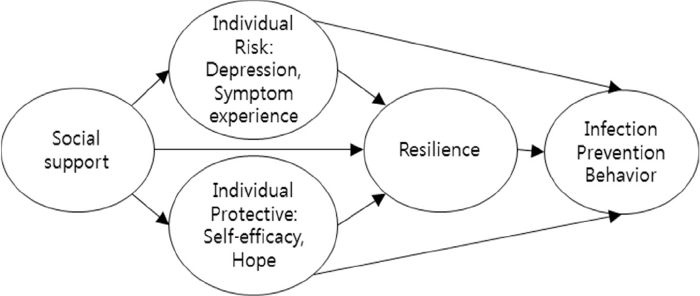
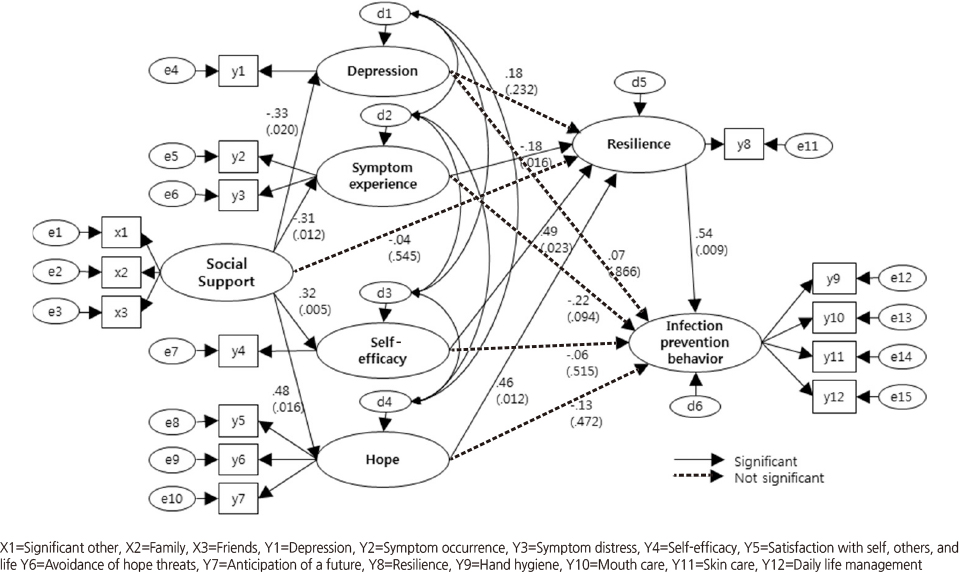
Figure 1
Figure 2
Descriptive Statistics of the Measured Variables (N=204)
Correlation among the Measured Variables (N=204)
Direct Effect, Indirect Effect and Total Effect in the Model (N=204)
*SMC=Squared multiple correlation.
*SMC=Squared multiple correlation.
 KSNS
KSNS
 E-SUBMISSION
E-SUBMISSION


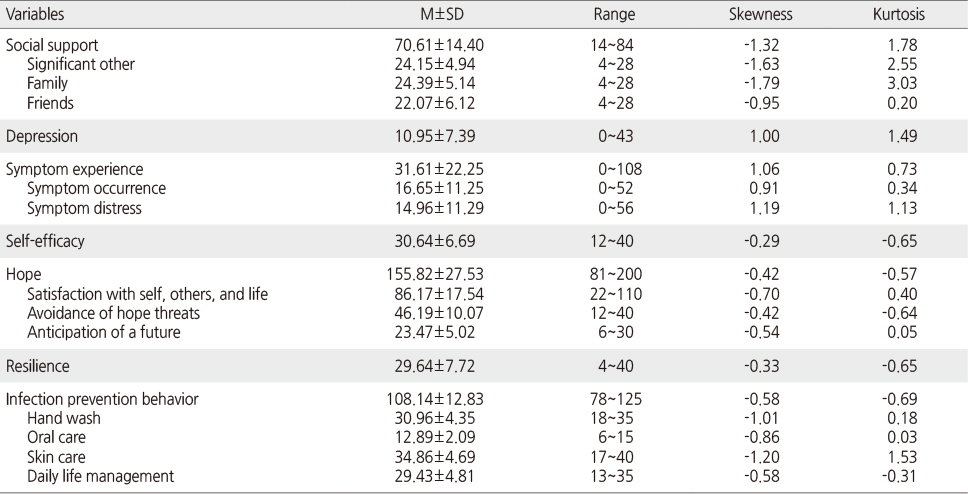
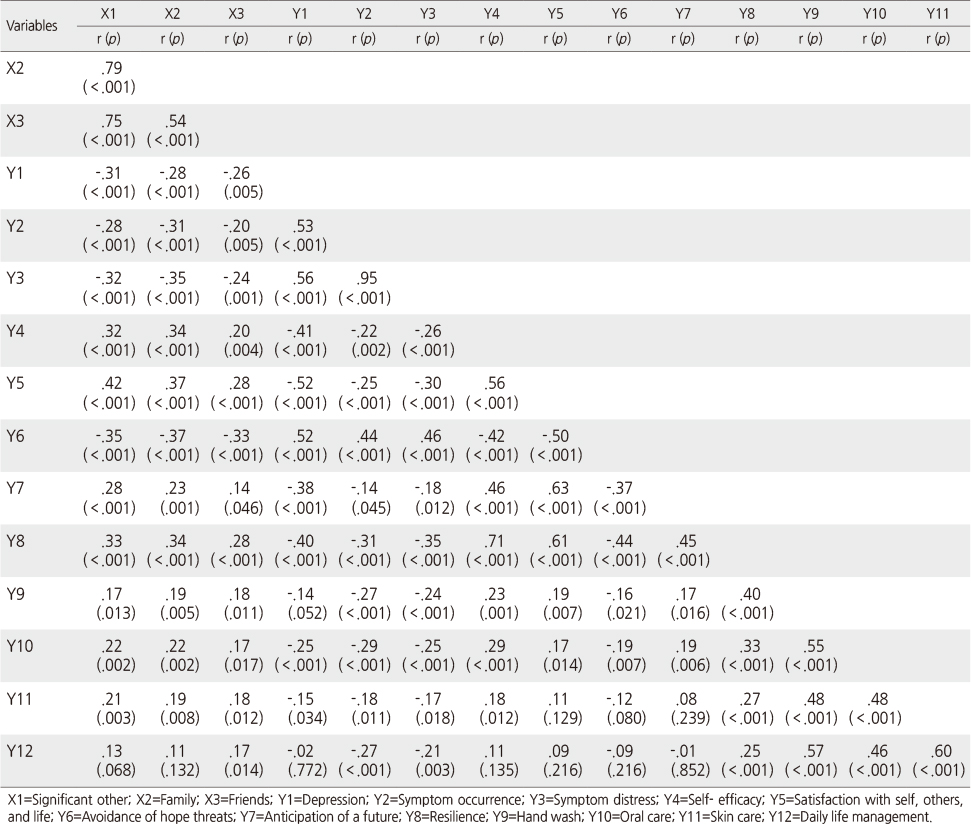
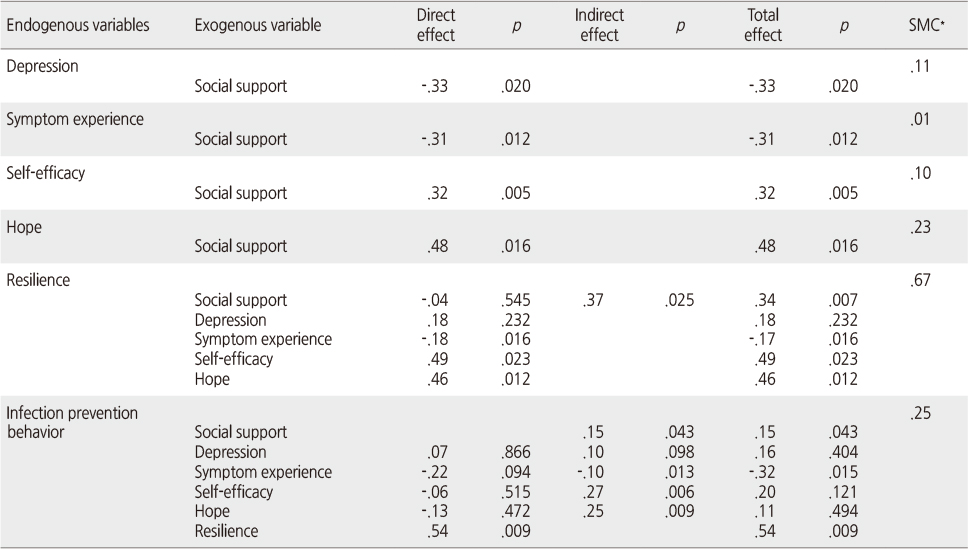
 Cite
Cite

